El Nido, located on the northern tip of Palawan Island in the Philippines, is a tropical paradise that has long been a favorite destination for travelers seeking pristine beaches, crystal-clear waters, and breathtaking landscapes. But beyond its postcard-perfect scenery, El Nido is also a world-class diving destination. With vibrant coral reefs, diverse marine life, and stunning underwater landscapes, Diving In El Nido is an experience like no other. Whether you’re a seasoned diver or a complete beginner, this guide will cover everything you need to know about diving in El Nido, from planning your trip and choosing the best dive spots to getting certified and making the most of your underwater adventure. Let’s dive in!
🤿 Diving In El Nido, Palawan
Table of contents
- 🤿 Diving In El Nido, Palawan
- 🗺️ Things to Know When Planning an El Nido Diving Trip
- 🛫 How to Get to El Nido
- 🏨 Where to Stay in El Nido
- 🌞 What Is the Best Time to Go Scuba Diving in El Nido?
- 🌊 Is Diving in El Nido Worth It?
- 🐠 What Are the Best Dive Spots Around El Nido?
- 😨 Is Diving Scary?
- 🎓 PADI Open Water Course Information Guide
- About El Nido Puro Divers 🐠
- Other Top Things to Do in El Nido 🏝️
- Diving in El Nido: In Conclusion 🌟
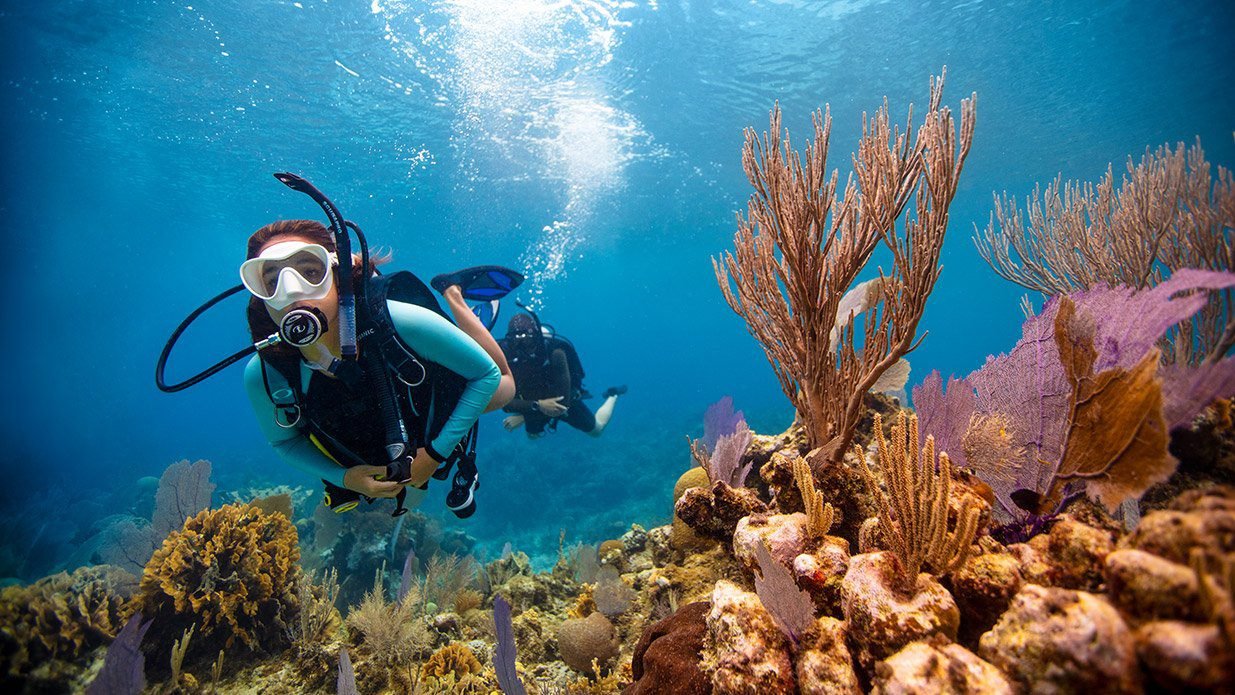
Disclosure: Some links in this post are affiliate links. If you make a purchase through one of these links, we may earn a small commission (at no extra cost to you!). We're very grateful when you use our links to make a purchase:-).
🗺️ Things to Know When Planning an El Nido Diving Trip
Planning a diving trip to El Nido, Palawan, is an exciting adventure, but it requires some preparation to ensure everything goes smoothly. From choosing the right time to visit to packing the essentials, there are several factors to consider. In this guide, we’ll cover everything you need to know when planning your Diving In El Nido trip, so you can focus on enjoying the stunning underwater world. Let’s dive in!
1. Choose the Right Time to Visit 📅
The best time for Diving In El Nido is during the dry season, which runs from November to May. During this period, the weather is sunny, and the seas are calm, providing excellent visibility for diving. Here’s a quick breakdown:
- November to February: Cooler temperatures and fewer crowds.
- March to May: Hot and sunny weather, ideal for diving and snorkeling.
Avoid the monsoon season (June to October), as heavy rains and rough seas can make diving conditions unsafe.
2. Book in Advance 🏨
El Nido is a popular destination, and dive centers and accommodations can fill up quickly, especially during peak season. Here’s what to book in advance:
- Dive Courses: If you’re planning to get certified, book your PADI Open Water Course or other diving programs early.
- Accommodation: Whether you’re staying in a hostel, guesthouse, or resort, make your reservations ahead of time.
- Flights and Transfers: Secure your flights and transportation to El Nido to avoid last-minute hassles.
3. Pack Wisely 🧳
Packing the right gear is essential for a successful diving trip. Here’s a checklist of what to bring:
- Reef-Safe Sunscreen: Protect your skin and the marine environment.
- Waterproof Bag: Keep your belongings dry during boat rides.
- Dive Certification: If you’re already certified, bring your PADI or SSI card.
- Underwater Camera: Capture your underwater adventures (if you’re comfortable handling it while diving).
- Lightweight Clothing: Pack breathable, quick-drying clothes for the tropical climate.
4. Stay Hydrated and Healthy 💧
Diving can be physically demanding, so it’s important to stay hydrated and healthy during your trip. Here are some tips:
- Drink Plenty of Water: Dehydration can increase the risk of decompression sickness.
- Eat Well: Fuel your body with nutritious meals, especially before and after dives.
- Rest: Allow time for your body to recover between dives.
5. Choose a Reputable Dive Center 🏫
Choosing the right dive center is crucial for a safe and enjoyable diving experience. Here’s what to look for:
- Experienced Instructors: Ensure the dive center has certified and experienced instructors.
- Small Group Sizes: Smaller groups mean more personalized attention and a safer experience.
- Good Reviews: Check online reviews and ask for recommendations from fellow travelers.
6. Understand the Costs 💸
Diving in El Nido is affordable, but it’s important to understand the costs involved. Here’s a breakdown:
- PADI Open Water Course: PHP 18,000-20,000 (USD 325-360).
- Fun Dives: PHP 2,500-3,500 (USD 45-63) for two dives.
- Equipment Rental: Included in most dive packages, but check in advance.
7. Respect the Marine Environment 🌊
El Nido is part of a protected marine park, so it’s important to dive responsibly. Here’s how:
- Avoid Touching Marine Life: Coral reefs are fragile and can be easily damaged.
- Use Reef-Safe Sunscreen: Protect the marine environment from harmful chemicals.
- Dispose of Waste Properly: Use designated bins and avoid littering.
8. Prepare for the Weather 🌞
The weather in El Nido can be unpredictable, so it’s important to be prepared. Here’s what to expect:
- Dry Season (November to May): Sunny and dry, ideal for diving.
- Wet Season (June to October): Heavy rains and rough seas, not ideal for diving.
9. Plan Your Itinerary 🗺️
El Nido offers a wide range of activities beyond diving, so plan your itinerary to make the most of your trip. Here are some top activities:
- Island-Hopping Tours: Explore the stunning Bacuit Archipelago.
- Kayaking: Paddle through hidden lagoons and beaches.
- Hiking: Climb Taraw Cliff for panoramic views.
10. Stay Safe 🛡️
Safety should always be your top priority when diving. Here are some tips:
- Follow Your Instructor’s Guidelines: Always listen to your dive instructor and follow safety procedures.
- Check Your Equipment: Ensure your gear is in good condition before each dive.
- Dive Within Your Limits: Don’t push yourself beyond your comfort level.
Planning a diving trip to El Nido requires some preparation, but the effort is well worth it. With its vibrant coral reefs, diverse marine life, and stunning underwater landscapes, Diving In El Nido is an experience like no other. Use this guide to plan your trip and make the most of your underwater adventure.
🛫 How to Get to El Nido
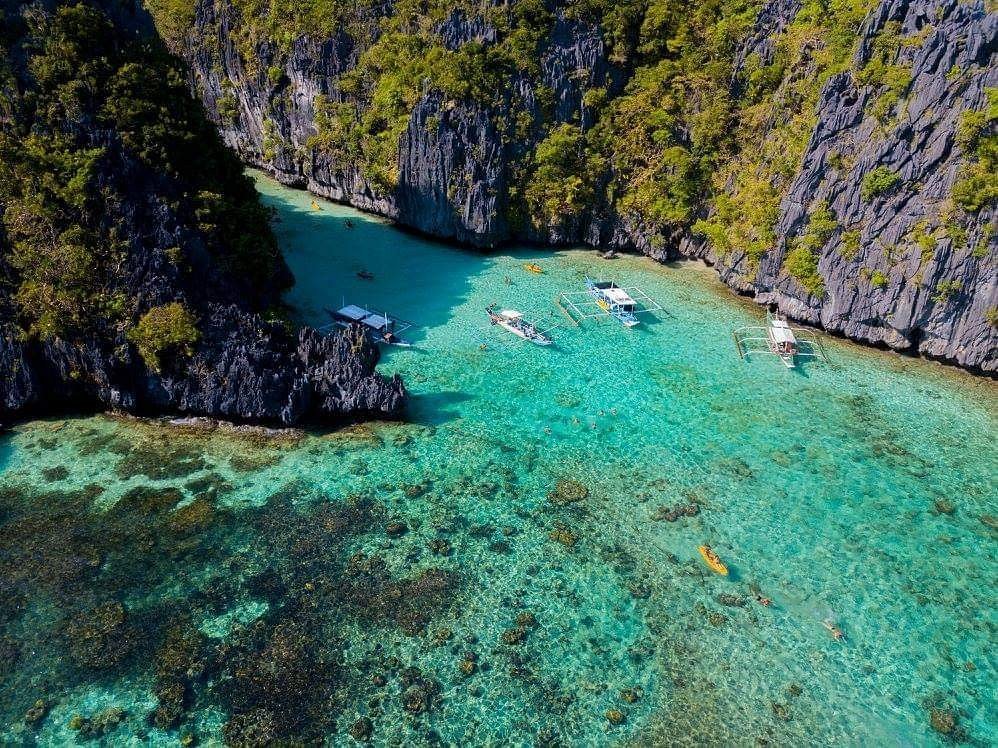
El Nido is accessible by air and land. Here are the most common ways to get there:
1. Direct Flight from Manila to El Nido (Lio Airport) ✈️
- Airlines: AirSwift offers direct flights from Manila to El Nido.
- Duration: 1.5 hours.
- Cost: PHP 5,000-8,000 (USD 90-145) one way.
- Book Here: AirSwift Flights
2. Flight from Manila to Puerto Princesa + Bus/Minivan to El Nido 🚐
- Step 1: Fly to Puerto Princesa (PPS) from Manila or Cebu.
- Step 2: Take a bus or minivan to El Nido (5-6 hours).
- Cost: PHP 500-800 (USD 9-15) for the bus/minivan.
Puerto Princesa – El Nido by Bus 🚌
- Operators: Cherry Bus and RORO Bus.
- Cost: PHP 500-600 (USD 9-11) per person.
El Nido – Puerto Princesa by Minivan 🚐
- Operators: Fort Wally and Daytripper Palawan.
- Cost: PHP 700-800 (USD 13-15) per person.
🏨 Where to Stay in El Nido
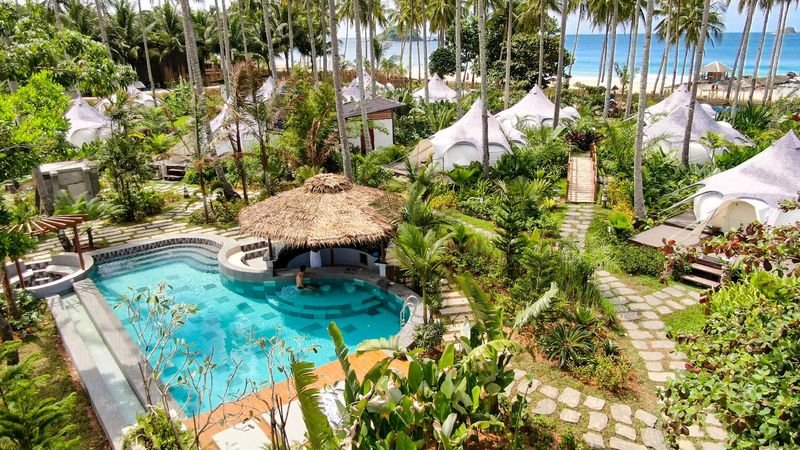
El Nido, with its stunning beaches, crystal-clear waters, and lush landscapes, offers a wide range of accommodations to suit every traveler’s needs and budget. Whether you’re looking for a luxurious beachfront resort, a cozy boutique hotel, or a budget-friendly hostel, you’ll find plenty of options in and around El Nido town. In this guide, we’ll break down the best places to stay in El Nido, complete with booking links and tips to help you choose the perfect accommodation for your tropical getaway. Let’s dive in!
1. Luxury Resorts 🌟
For travelers seeking a luxurious and relaxing experience, El Nido offers several high-end resorts with world-class amenities and stunning views.
a) El Nido Resorts Pangulasian Island 🏝️
- Location: Pangulasian Island.
- Price Range: PHP 20,000-30,000 (USD 360-540) per night.
- Highlights:
- Eco-luxury resort with overwater villas and private beaches.
- Infinity pool, spa, and fine dining options.
- Perfect for honeymooners and couples.
- Book Here: Pangulasian Island on Booking.com
b) Seda Lio 🌴
- Location: Lio Tourism Estate.
- Price Range: PHP 8,000-12,000 (USD 145-220) per night.
- Highlights:
- Modern resort with a private beach and infinity pool.
- On-site restaurant, spa, and fitness center.
- Great for families and couples.
- Book Here: Seda Lio on Booking.com
c) Cauayan Island Resort 🏖️
- Location: Cauayan Island.
- Price Range: PHP 10,000-15,000 (USD 180-270) per night.
- Highlights:
- Secluded resort with private villas and stunning ocean views.
- Perfect for a peaceful and luxurious getaway.
- Book Here: Cauayan Island Resort on Booking.com
2. Mid-Range Hotels and Resorts 🌴
If you’re looking for comfortable accommodations without breaking the bank, these mid-range options are perfect for you.
a) Spin Designer Hostel 🎨
- Location: El Nido Town.
- Price Range: PHP 1,500-2,500 (USD 27-45) per night.
- Highlights:
- Stylish and affordable hostel with a rooftop bar.
- Great for solo travelers and backpackers.
- Book Here: Spin Designer Hostel on Booking.com
b) Happiness Beach Resort 🌞
- Location: Corong-Corong Beach.
- Price Range: PHP 3,000-5,000 (USD 54-90) per night.
- Highlights:
- Beachfront resort with comfortable rooms and stunning views.
- On-site restaurant and bar.
- Book Here: Happiness Beach Resort on Booking.com
c) Cadlao Resort and Restaurant 🏖️
- Location: Corong-Corong Beach.
- Price Range: PHP 2,500-4,000 (USD 45-72) per night.
- Highlights:
- Beachfront resort with a relaxed atmosphere.
- On-site restaurant serving delicious local and international cuisine.
- Book Here: Cadlao Resort on Booking.com
3. Budget-Friendly Options 💸
For budget-conscious travelers, El Nido offers a variety of affordable accommodations that don’t compromise on comfort.
a) Frendz Hostel El Nido 🛏️
- Location: El Nido Town.
- Price Range: PHP 800-1,200 (USD 14-22) per night.
- Highlights:
- Social hostel with a lively bar and communal areas.
- Perfect for meeting other travelers.
- Book Here: Frendz Hostel on Booking.com
b) Our Melting Pot Hostel 🏠
- Location: El Nido Town.
- Price Range: PHP 700-1,000 (USD 13-18) per night.
- Highlights:
- Affordable and clean hostel with a friendly atmosphere.
- Great for solo travelers and backpackers.
- Book Here: Our Melting Pot Hostel on Booking.com
c) OMP Coral Beach Hostel 🌊
- Location: Corong-Corong Beach.
- Price Range: PHP 1,000-1,500 (USD 18-27) per night.
- Highlights:
- Beachfront hostel with stunning views and a relaxed vibe.
- Perfect for budget travelers who want to be close to the beach.
- Book Here: OMP Coral Beach Hostel on Booking.com
4. Eco-Friendly Resorts 🌿
For travelers who prioritize sustainability, El Nido offers several eco-friendly resorts that focus on preserving the natural beauty of the area.
a) Entalula Beach Cottages 🏡
- Location: Entalula Island.
- Price Range: PHP 6,000-8,000 (USD 108-145) per night.
- Highlights:
- Eco-friendly cottages with stunning ocean views.
- Perfect for a peaceful and sustainable getaway.
- Book Here: Entalula Beach Cottages on Booking.com
b) Nacpan Beach Glamping ⛺
- Location: Nacpan Beach.
- Price Range: PHP 3,000-5,000 (USD 54-90) per night.
- Highlights:
- Glamping tents with comfortable beds and modern amenities.
- Located on one of the most beautiful beaches in El Nido.
- Book Here: Nacpan Beach Glamping on Booking.com
Tips for Choosing the Perfect Accommodation 🛎️
- Book Early: El Nido is a popular destination, so book your accommodation well in advance, especially during peak season (March-May).
- Consider Location: If you want to be close to the action, stay in El Nido town. For a more peaceful experience, choose a beachfront resort.
- Check Reviews: Read reviews on platforms like Booking.com or TripAdvisor to ensure you choose a reputable place.
- Pack Light: Most accommodations in El Nido are simple, so bring only the essentials.
El Nido offers a wide range of accommodations to suit every traveler’s needs and budget. Whether you’re looking for a luxurious beachfront resort, a cozy boutique hotel, or a budget-friendly hostel, you’ll find the perfect place to stay in this tropical paradise. Use this guide to plan your trip and get ready for an unforgettable experience in El Nido!
🌞 What Is the Best Time to Go Scuba Diving in El Nido?
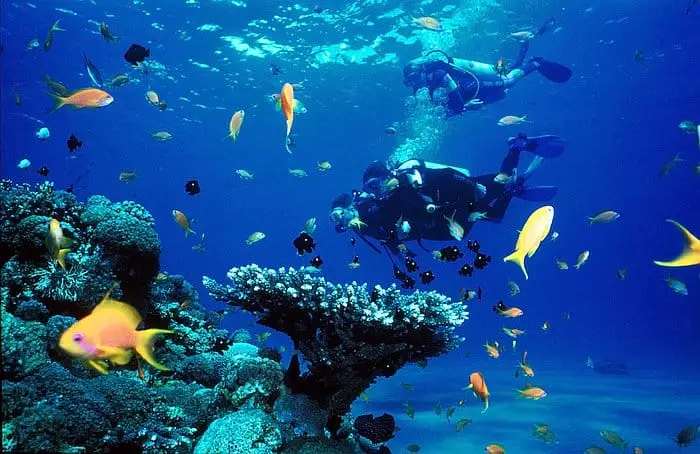
The best time for Diving In El Nido is during the dry season (November to May), when the weather is sunny, and the seas are calm. Visibility is at its best during this period, making it ideal for underwater exploration.
🌊 Is Diving in El Nido Worth It?
El Nido, located on the northern tip of Palawan Island in the Philippines, is renowned for its stunning beaches, crystal-clear waters, and breathtaking landscapes. But beyond its above-ground beauty, El Nido is also a world-class diving destination. With vibrant coral reefs, diverse marine life, and stunning underwater landscapes, Diving In El Nido is an experience like no other. But is it worth it? In this guide, we’ll explore why diving in El Nido is a must-do activity and what makes it so special. Let’s dive in!
Why Diving in El Nido is Worth It 🌟
1. Vibrant Coral Reefs 🐚
El Nido is home to some of the most vibrant coral reefs in the Philippines. The Bacuit Archipelago, which surrounds El Nido, is part of a protected marine park, ensuring the reefs remain healthy and teeming with life.
- Coral Diversity: Over 500 species of coral can be found in El Nido’s waters.
- Colorful Marine Life: The reefs are home to a variety of fish, crustaceans, and other marine creatures.
2. Diverse Marine Life 🐠
El Nido’s waters are a haven for marine biodiversity. Here’s what you can expect to see:
- Sea Turtles: Green and hawksbill turtles are commonly spotted.
- Reef Sharks: Blacktip and whitetip reef sharks are often seen.
- Colorful Fish: Parrotfish, clownfish, and angelfish are just a few of the many species you’ll encounter.
3. Stunning Underwater Landscapes 🌊
El Nido’s underwater landscapes are as breathtaking as its above-ground scenery. Here are some highlights:
- Caves and Tunnels: Explore underwater caves and tunnels, such as the famous Dilumacad Tunnel.
- Drop-Offs and Walls: Experience dramatic drop-offs and walls covered in soft corals and sponges.
- Hidden Lagoons: Discover hidden lagoons and secret beaches accessible only by water.
4. Affordable Diving 💸
Compared to other popular diving destinations, diving in El Nido is incredibly affordable. Here’s a breakdown of costs:
- Fun Dives: PHP 2,500-3,500 (USD 45-63) for two dives.
- PADI Open Water Course: PHP 18,000-20,000 (USD 325-360).
- Equipment Rental: Included in most dive packages.
5. Suitable for All Levels 🤿
Whether you’re a beginner or an experienced diver, El Nido offers something for everyone.
- Beginners: Take a PADI Open Water Course or try a Discover Scuba Diving experience.
- Experienced Divers: Explore advanced dive sites like North Rock and South Miniloc.
What Makes Diving in El Nido Special? 🌴
1. Protected Marine Park 🐢
El Nido is part of the El Nido-Taytay Managed Resource Protected Area, ensuring the marine environment is well-preserved.
2. World-Class Dive Sites 🏝️
El Nido boasts some of the best dive sites in the Philippines, including:
- South Miniloc: Known for its vibrant coral gardens.
- Dilumacad Tunnel: A unique underwater tunnel.
- North Rock: Famous for its strong currents and large pelagic species.
3. Experienced Dive Centers 🏫
El Nido is home to several reputable dive centers, such as El Nido Puro Divers and Submariner Diving Center, offering professional instruction and guided dives.
Is Diving in El Nido Worth It for Beginners? 🎓
Absolutely! El Nido is a great place for beginners to learn how to dive. Here’s why:
- Beginner-Friendly Dive Sites: Many dive sites are suitable for beginners, with calm waters and shallow depths.
- Professional Instruction: Experienced instructors provide thorough training and guidance.
- Affordable Courses: The PADI Open Water Course is reasonably priced and offers excellent value for money.
Is Diving in El Nido Worth It for Experienced Divers? 🌊
Yes! Experienced divers will find plenty to explore in El Nido, including:
- Advanced Dive Sites: Sites like North Rock and South Miniloc offer challenging dives with strong currents and deep drop-offs.
- Unique Underwater Features: Explore caves, tunnels, and walls covered in soft corals and sponges.
- Diverse Marine Life: Spot large pelagic species, reef sharks, and sea turtles.
Diving In El Nido is absolutely worth it! With its vibrant coral reefs, diverse marine life, and stunning underwater landscapes, El Nido offers an unforgettable diving experience for all levels. Whether you’re a beginner looking to get certified or an experienced diver seeking new adventures, El Nido has something for everyone.
🐠 What Are the Best Dive Spots Around El Nido?
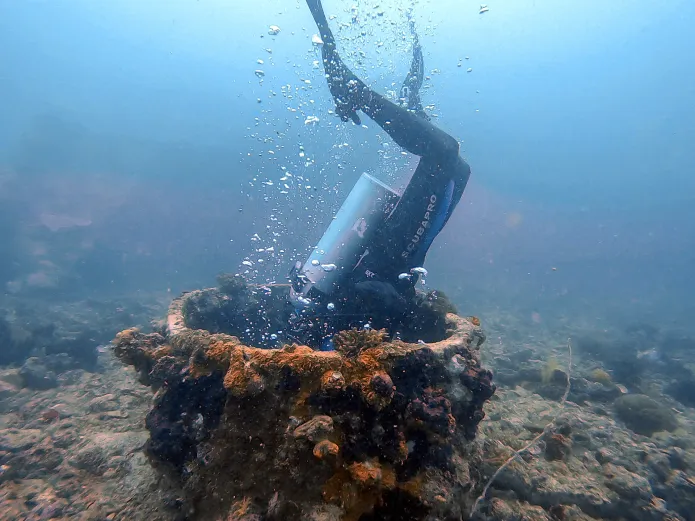
El Nido, located on the northern tip of Palawan Island in the Philippines, is a diver’s paradise. With its vibrant coral reefs, diverse marine life, and stunning underwater landscapes, Diving In El Nido offers an unforgettable experience for divers of all levels. But with so many incredible dive sites to choose from, where should you start? In this guide, we’ll explore the best dive spots around El Nido, complete with details on what makes each site special. Let’s dive in!
1. South Miniloc 🐠
Highlights:
- Vibrant Coral Gardens: South Miniloc is known for its stunning coral gardens, teeming with colorful fish and marine life.
- Diverse Marine Life: Spot sea turtles, reef sharks, and schools of jackfish.
- Depth: 10-30 meters (33-98 feet).
Why Dive Here?
South Miniloc is perfect for both beginners and experienced divers, offering a mix of shallow and deep dive sites with plenty to explore.
2. Dilumacad Tunnel 🚤
Highlights:
- Unique Underwater Tunnel: This site features a unique underwater tunnel that divers can swim through.
- Soft Corals and Sponges: The tunnel is covered in soft corals and sponges, creating a stunning underwater landscape.
- Depth: 15-30 meters (49-98 feet).
Why Dive Here?
Dilumacad Tunnel is a must-visit for experienced divers looking for a unique and challenging dive.
3. North Rock 🦈
Highlights:
- Strong Currents: North Rock is known for its strong currents, making it a challenging dive.
- Large Pelagic Species: Spot large pelagic species like barracudas, trevallies, and reef sharks.
- Depth: 15-30 meters (49-98 feet).
Why Dive Here?
North Rock is ideal for experienced divers seeking an adrenaline-pumping dive with the chance to see large marine life.
4. Twin Rocks 🐙
Highlights:
- Two Large Rock Formations: Twin Rocks features two large rock formations that are home to a variety of marine life.
- Colorful Fish: Spot parrotfish, clownfish, and angelfish.
- Depth: 10-20 meters (33-65 feet).
Why Dive Here?
Twin Rocks is great for beginners and intermediate divers, offering a mix of shallow and deep dive sites with plenty to see.
5. Pangulasian Island 🏝️
Highlights:
- Healthy Coral Reefs: Pangulasian Island is known for its healthy coral reefs and diverse marine life.
- Sea Turtles: Spot green and hawksbill turtles.
- Depth: 10-25 meters (33-82 feet).
Why Dive Here?
Pangulasian Island is perfect for divers of all levels, offering a mix of shallow and deep dive sites with plenty of marine life.
6. Sibaltan Wall 🌊
Highlights:
- Dramatic Drop-Offs: Sibaltan Wall features dramatic drop-offs and walls covered in soft corals and sponges.
- Reef Sharks: Spot blacktip and whitetip reef sharks.
- Depth: 15-30 meters (49-98 feet).
Why Dive Here?
Sibaltan Wall is ideal for experienced divers looking for a challenging dive with stunning underwater landscapes.
7. Entalula Island 🐢
Highlights:
- Vibrant Coral Reefs: Entalula Island is known for its vibrant coral reefs and diverse marine life.
- Sea Turtles: Spot green and hawksbill turtles.
- Depth: 10-20 meters (33-65 feet).
Why Dive Here?
Entalula Island is great for divers of all levels, offering a mix of shallow and deep dive sites with plenty to explore.
8. Cadlao Island 🏖️
Highlights:
- Stunning Underwater Landscapes: Cadlao Island features stunning underwater landscapes, including caves and tunnels.
- Colorful Fish: Spot parrotfish, clownfish, and angelfish.
- Depth: 10-25 meters (33-82 feet).
Why Dive Here?
Cadlao Island is perfect for divers of all levels, offering a mix of shallow and deep dive sites with plenty of marine life.
9. Matinloc Shrine ⛪
Highlights:
- Underwater Shrine: Matinloc Shrine features an underwater shrine and stunning coral reefs.
- Diverse Marine Life: Spot sea turtles, reef sharks, and colorful fish.
- Depth: 10-20 meters (33-65 feet).
Why Dive Here?
Matinloc Shrine is great for divers of all levels, offering a unique underwater experience with plenty to see.
10. Secret Beach 🏝️
Highlights:
- Hidden Beach: Secret Beach is a hidden beach accessible only by swimming through a small opening in the rocks.
- Vibrant Coral Reefs: The beach is surrounded by vibrant coral reefs and diverse marine life.
- Depth: 5-15 meters (16-49 feet).
Why Dive Here?
Secret Beach is perfect for beginners and intermediate divers, offering a unique and memorable dive experience.
El Nido offers some of the best dive spots in the Philippines, with something for every level of diver. From vibrant coral reefs and diverse marine life to stunning underwater landscapes, Diving In El Nido is an experience you won’t want to miss. Use this guide to plan your dives and make the most of your underwater adventure.
😨 Is Diving Scary?
Diving is an exhilarating and rewarding experience, but it’s natural to feel a bit nervous, especially if you’re a beginner. The idea of breathing underwater, navigating unfamiliar environments, and encountering marine life can be intimidating. But is diving really scary? In this guide, we’ll explore the common fears associated with diving, how to overcome them, and why diving is a safe and enjoyable activity for everyone. Let’s dive in!
Common Fears About Diving 😨
1. Fear of Breathing Underwater 🌬️
One of the most common fears is the idea of breathing underwater. It’s a completely new experience, and it can feel unnatural at first.
- Why It’s Safe: Scuba equipment is designed to make breathing underwater easy and comfortable. Your regulator delivers air on demand, so you can breathe naturally.
- How to Overcome It: Practice breathing through your regulator in a controlled environment, like a swimming pool, before your first open water dive.
2. Fear of the Unknown 🌊
The underwater world is unfamiliar, and the idea of exploring it can be daunting.
- Why It’s Safe: Dive sites are carefully chosen for their safety and accessibility. Your dive instructor will guide you every step of the way.
- How to Overcome It: Start with a Discover Scuba Diving experience or a beginner-friendly dive site to build your confidence.
3. Fear of Marine Life 🐠
Encountering marine life, especially larger creatures like sharks, can be intimidating.
- Why It’s Safe: Most marine creatures are more afraid of you than you are of them. Sharks, for example, are generally not aggressive toward humans.
- How to Overcome It: Learn about the marine life you’ll encounter and how to interact with them safely.
4. Fear of Equipment Failure 🛠️
The idea of your equipment failing underwater can be scary.
- Why It’s Safe: Scuba equipment is rigorously tested and maintained. Your dive instructor will check your equipment before each dive.
- How to Overcome It: Learn how your equipment works and practice using it in a controlled environment.
5. Fear of Getting Lost 🗺️
Navigating underwater can be challenging, and the idea of getting lost can be frightening.
- Why It’s Safe: Dive instructors and guides are trained to navigate underwater and will ensure you stay on course.
- How to Overcome It: Practice your navigation skills and always stay close to your dive buddy or guide.
How to Overcome Your Fears 🛡️
1. Take a Professional Course 🎓
Enroll in a PADI Open Water Course or a Discover Scuba Diving program. Professional instruction will give you the knowledge and skills you need to dive safely and confidently.
2. Start in a Controlled Environment 🏊♀️
Begin your diving journey in a swimming pool or shallow water. This will help you get comfortable with the equipment and breathing underwater.
3. Practice Relaxation Techniques 🧘♀️
Relaxation is key to enjoying your dive. Practice deep breathing and mindfulness techniques to stay calm underwater.
4. Dive with a Buddy 🤝
Diving with a buddy or guide can provide reassurance and support. Always stay close to your buddy and communicate regularly.
5. Take It Slow 🐢
Don’t rush your diving experience. Take your time to get comfortable with each step, from breathing underwater to navigating dive sites.
Why Diving is Safe and Enjoyable 🌟
1. Professional Training 🏫
Dive instructors are highly trained and certified to ensure your safety. They will guide you through every step of your diving journey.
2. Rigorous Equipment Standards 🛠️
Scuba equipment is rigorously tested and maintained to ensure it functions properly. Your instructor will check your equipment before each dive.
3. Controlled Environments 🌊
Dive sites are carefully chosen for their safety and accessibility. Your instructor will ensure you dive in conditions that match your skill level.
4. Buddy System 🤝
The buddy system ensures you always have someone to rely on underwater. Your buddy can assist you in case of an emergency.
Diving can be intimidating at first, but with proper training and preparation, it’s a safe and enjoyable activity for everyone. By understanding and overcoming your fears, you can unlock the incredible underwater world and experience the beauty of Diving In El Nido and other amazing destinations.
🎓 PADI Open Water Course Information Guide
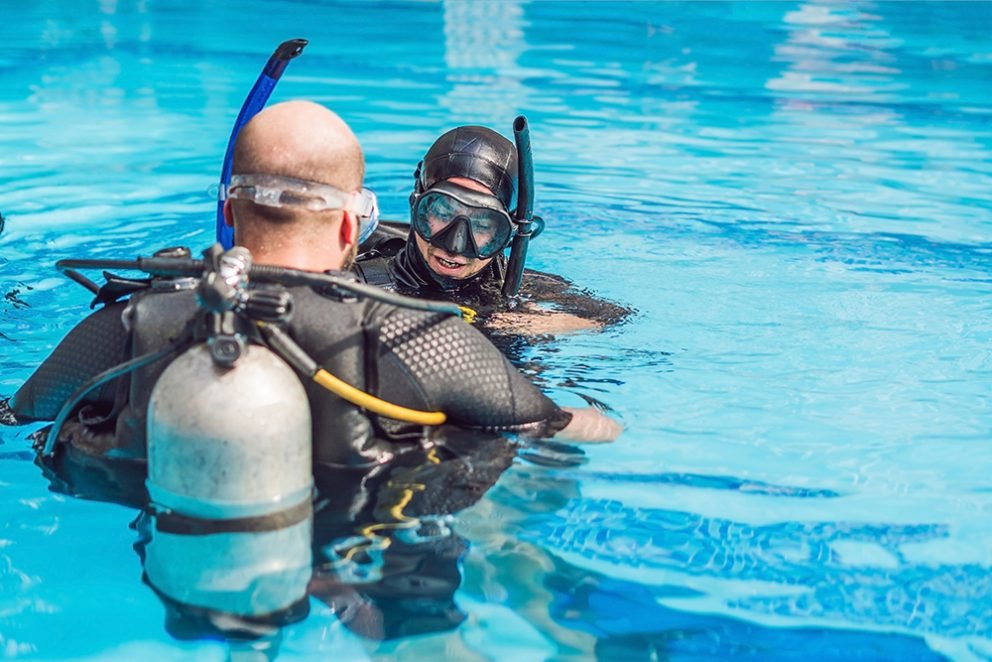
The PADI Open Water Course is the most popular diving certification for beginners, offering the skills and knowledge you need to dive safely and confidently. Whether you’re dreaming of exploring coral reefs, swimming with sea turtles, or simply experiencing the thrill of breathing underwater, this course is your gateway to the underwater world. In this guide, we’ll cover everything you need to know about the PADI Open Water Course, from what it entails to how to get started. Let’s dive in!
What is the PADI Open Water Course? 🎓
The PADI Open Water Course is the first step in becoming a certified diver. It’s designed for beginners and provides the foundational skills and knowledge needed to dive safely and confidently.
Key Features:
- Certification: Upon completion, you’ll receive a PADI Open Water Diver certification, recognized worldwide.
- Flexibility: The course can be completed in as little as 3-4 days or spread out over a longer period.
- Accessibility: No prior diving experience is required.
What Does the Course Include? 📚
The PADI Open Water Course consists of three main components:
1. Theory 📖
- Purpose: Learn the basics of diving, including safety procedures, equipment, and underwater communication.
- Format: Online eLearning or in-person classroom sessions.
- Topics Covered:
- Dive equipment and how it works.
- Underwater physics and physiology.
- Dive planning and safety procedures.
2. Confined Water Dives 🏊♀️
- Purpose: Practice essential diving skills in a controlled environment, such as a swimming pool or shallow water.
- Skills Covered:
- Setting up and using scuba equipment.
- Breathing underwater and clearing your mask.
- Buoyancy control and underwater navigation.
3. Open Water Dives 🌊
- Purpose: Apply your skills and knowledge in real diving conditions.
- Requirements: Complete four open water dives over two days.
- Skills Covered:
- Demonstrating essential diving skills.
- Exploring dive sites and interacting with marine life.
How to Get Started 🚀
1. Choose a Dive Center 🏫
- Look for a PADI-certified dive center with experienced instructors.
- Read reviews and ask for recommendations from fellow travelers.
2. Enroll in the Course 📝
- Sign up for the course online or in person.
- Complete the theory portion through PADI eLearning or in-person classroom sessions.
3. Prepare for Your Dives 🧳
- Pack lightweight, quick-drying clothing and reef-safe sunscreen.
- Bring a reusable water bottle and any personal medications.
What to Expect During the Course 🗓️
Day 1: Theory 📚
- Morning: Complete the theory portion through eLearning or classroom sessions.
- Afternoon: Review key concepts and take a quiz to test your knowledge.
Day 2: Confined Water Dives 🏊♀️
- Morning: Practice essential diving skills in a controlled environment.
- Afternoon: Continue practicing skills and build your confidence underwater.
Day 3: Open Water Dives 🌊
- Morning: Complete your first two open water dives, demonstrating essential skills and exploring dive sites.
- Afternoon: Complete your final two open water dives and receive your certification.
Why Take the PADI Open Water Course? 🌟
1. Worldwide Recognition 🌍
- The PADI Open Water Diver certification is recognized worldwide, allowing you to dive anywhere in the world.
2. Safety and Confidence 🛡️
- The course provides the skills and knowledge needed to dive safely and confidently.
3. Access to Amazing Dive Sites 🐠
- With your certification, you’ll have access to some of the world’s most stunning dive sites, including Diving In El Nido.
4. Lifetime of Adventure 🌴
- Diving opens up a whole new world of adventure and exploration.
The PADI Open Water Course is your gateway to the underwater world, offering the skills and knowledge you need to dive safely and confidently. Whether you’re dreaming of exploring coral reefs, swimming with sea turtles, or simply experiencing the thrill of breathing underwater, this course is the first step in your diving journey.
About El Nido Puro Divers 🐠
El Nido Puro Divers is one of the most reputable dive centers in El Nido, offering a range of courses and guided dives. Their experienced instructors and small group sizes ensure a safe and enjoyable experience.
Other Top Things to Do in El Nido 🏝️
- Island-Hopping Tours: Explore the stunning Bacuit Archipelago.
- Kayaking: Paddle through hidden lagoons and beaches.
- Hiking: Climb Taraw Cliff for panoramic views.
Diving in El Nido: In Conclusion 🌟
Diving In El Nido is an unforgettable experience that offers something for everyone, from beginners to experienced divers. With its vibrant coral reefs, diverse marine life, and stunning underwater landscapes, El Nido is a must-visit destination for any diving enthusiast. Use this guide to plan your trip and make the most of your underwater adventure.
So pack your bags, grab your diving gear, and get ready to explore the underwater wonders of El Nido!
If you have any questions, leave a comment below or send me a message!
Read More Similar Articles
- The Perfect 3 Day Siem Reap Itinerary and Travel Guide 🌏
- Cambodia Travel Budget - Best Travel Guide (2025)🌏💸
- The Best Luxury Hotels in Bali: A Paradise of Opulence and Serenity 🌴✨
- 2 Week Bali Itinerary -The Perfect Itinerary For First Time Visitors
- The Perfect 2 Week Laos Itinerary And Travel Guide
- Laos Travel Budget: How Much Does It Cost To Travel Laos?
- Hiking In Vang Vieng: The Most Beautiful Place In Laos
- The Ultimate Langkawi Itinerary: Your Complete Travel Guide to Malaysia’s Tropical Paradise
- Malaysia Travel Budget: Your Ultimate Guide to Exploring Malaysia on Any Budget
- The Perfect 2 Week Malaysia Itinerary: Your Ultimate Travel Guide
- El Nido Travel Guide With The Best Things to do (2025)
- The Philippines On A Budget: Detailed Philippines Travel Budget
